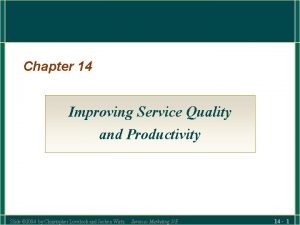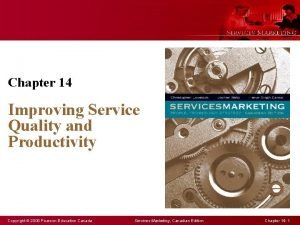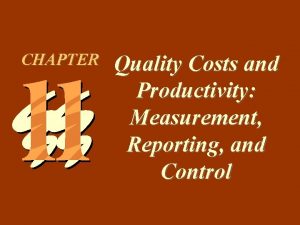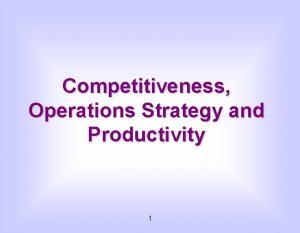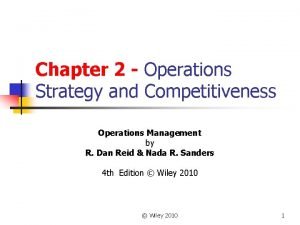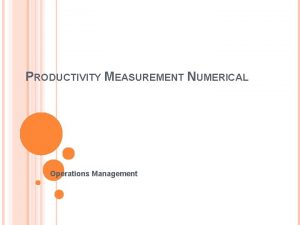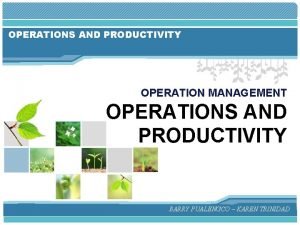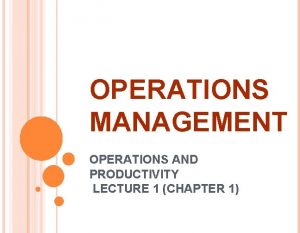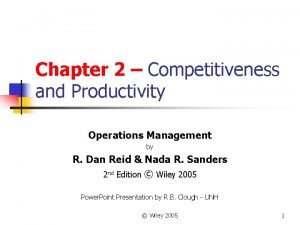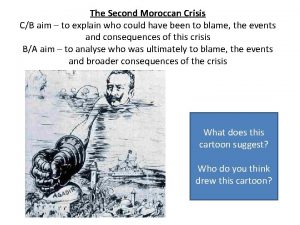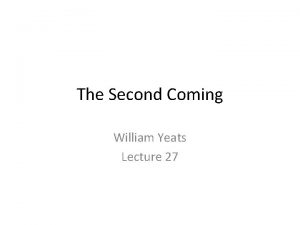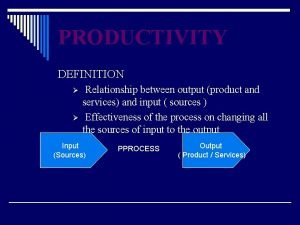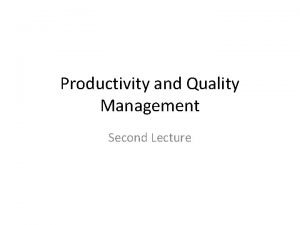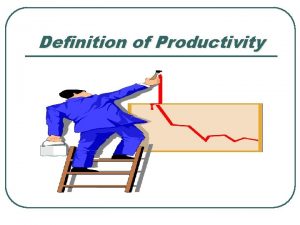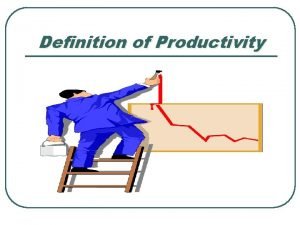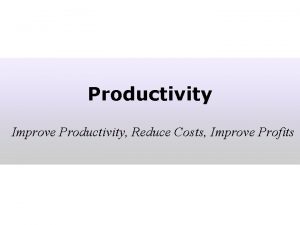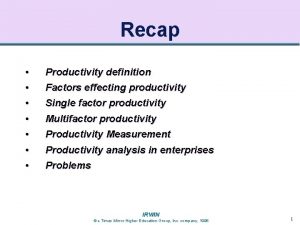Productivity and Quality Management Second Lecture Summary of



















































- Slides: 51

Productivity and Quality Management Second Lecture

Summary of Last Lecture • The Concept of Productivity and Quality

Lecture No 2 • Productivity Concept • The Concept of Productivity

ROLE OF PRODUCTIVITY

Role of Productivity • The role of Productivity in increasing national welfare is now universally recognized. • In every country, developed or developing, with a market economy or a centrally planned economy, the main source of economic growth is an increase in productivity. • Inversely, slackening of growth, stagnation and decline entail or are accompanied by a slow-down in productivity improvement.

Role of Productivity • Many studies have analyzed the decelerating growth of productivity, particularly in the advanced industrialized countries in the 1970 s and 1980 s. • Despite this keen interest, no adequate single explanation for low productivity growth has yet been found.

Role of Productivity • This lecture presents some definitions and explains the essential role of productivity in the business expansion which is necessary for social and economic development.

PRODUCTIVITY CONCEPT

Productivity Concept • What is productivity? • A general definition is that productivity is the relationship between the output generated by a production or service system and the input provided to create this output. • Thus, productivity is defined as the efficient use of resources – labour, capital, land, material, energy, information – in the production of various goods and services.

Productivity Concept • The role of Productivity in increasing national welfare is now universally recognized. In every country, developed or developing, with a market economy or a centrally planned economy, the main source of economic growth is an increase in productivity. Inversely, slackening of growth, stagnation and decline entail or are accompanied by a slow-down in productivity improvement.

Productivity Concept • Higher productivity means accomplishing more with the same amount of resources or achieving higher output in terms of volume and quantity for the same input. This is usually stated as : • Productivity = Output/Input

Productivity Concept • Productivity can also be defined as the relationship between results and the time it takes to accomplish them. • Time is often a good denominator since it is a universal measurement, and it is beyond human control. • The less time taken to achieve the desired result, the more productive the system is.

Productivity Concept • Regardless of the type of production, economic or political system, the definition of productivity remains the same. • Thus, though productivity may mean different things to different people, the basic concept is always the relationship between the quantity and quality of goods or services produced and quantity of resources used to produce them.

Productivity Challenge Productivity is the ratio of outputs (goods and services) divided by the inputs (resources such as labor and capital) The objective is to improve productivity! Important Note! Production is a measure of output only and not a measure of efficiency © 2011 Pearson Education, Inc. publishing as Prentice Hall

The Economic System Inputs Labor, capital, management Transformation The U. S. economic system transforms inputs to outputs at about an annual 2. 5% increase in productivity per year. The productivity increase is the result of a mix of capital (38% of 2. 5%), labor (10% of 2. 5%), and management (52% of 2. 5%). Outputs Goods and services Feedback loop Figure 1. 6 © 2011 Pearson Education, Inc. publishing as Prentice Hall

Productivity • Single-factor measures – Output / (Single Input) • All-factors measure – Output / (Total Inputs) 16

Measures of Productivity Single-factor Output measures Labor All-factors measure Output Machine Output Capital Output Energy Output All inputs 17

Some Single Factor Measurements • Labor Productivity – Quantity (or value) of output / labor hrs – Quantity (or value) of output / shift • Machine Productivity – Quantity (or value) of output / machine hrs • Energy Productivity – Quantity (or value of output) / kwh • Capital Productivity – Quantity (or value) of output / value of input 18

Productivity Role • Productivity is a comprehensive tool for managers, industrial engineers, economists and politicians. It compares production at different levels of the economic system (individual and shop-floor, organizational, sectoral ad national) with resources consumed.

Productivity Role • Sometimes productivity is viewed as a more intensive use of such resources as labour and machines which should reliably indicate performance or efficiency if measured accurately. • However, it is important to separate productivity from intensity of lobour, because while labour productivity reflects the beneficial results of labour, its intensity means excess effort and is no more than work – speed-up.

Productivity Improvement • The essence of productivity improvement is working more intelligently, not harder. • Real productivity improvement is not achieved by working harder: this results in very limited increases in productivity due to man`s physical limitations.

Productivity Improvement • The ILO has for many years promoted an advanced view of productivity which refers to the effective and efficient utilization of all resources, capital, land, material, energy, information and time, in addition to labour. • In promoting such views, one must combat some common misunderstandings about productivity.

Misconceptions • First, productivity is not only labour efficiency or ``labour productivity`` - although labour productivity statistics are still useful policy making data. • The false conclusions which may be drawn from analyses of single factor productivity are demonstrated by a major British productivity success story: agriculture.

Misconceptions • The second misconception is that it is possible to judge performance simply by output. • The lattermay be rising without an increase in productivity if, for instance, input costs have risen disproportionately. • Moreover, increases in output compared with previous years should take into account price increases and inflation. • Such an approach is often the result of being processoriented at the expense of paying attention of final results. • This is common in any bureaucratic system.

Misconceptions • The third problem is confusion between productivity and profitability. • In real life profit can be obtained through price recovery even though productivity may have gone down. • Conversely, high productivity does not always go with high profit since goods which are produced efficiently are not necessarily in demand.

Misconceptions • Fourth there is one more misunderstanding – confusing productivity with efficiency. • Efficiency means producing high-quality goods in the shortest possible time. • But we have to consider if these good are needed.

Misconceptions • A fifth mistake is to believe that cost cutting always improves productivity. When done indiscriminately, it can make matters worse in the long term.

Misconceptions • Another myth which causes damage is that productivity can only be applied to production. • In reality, productivity is relevant to nay kind of organization or system, including services, notably information. • With the changing structure of occupations, information specialists have become a new target for productivity drives. • Information technology itself gives new dimensions to productivity concepts and productivity measurement.

• In these days of flexible automation, microprocessors, just-in-time manufacturing and distribution systems, and mixed-flow production systems, work-ours are less relevant as a measure of effectiveness than in the past. • In fact, in industries and regions where ``steel-collar`` workers or robots are replacing blue-collar workers, the productivity of capital or other expensive, scarce resources such as energy or raw materials is of far more concern than labour productivity.

Productivity and Quality • The concept of productivity is also increasingly linked with quality – of output, input and the process itself. • An element of key importance is the quality of the work force, its management and its working conditions, and it has been generally recognized that rising productivity and improving quality of working life de tend to go hand in hand.

• By productivity, management and union policy makers refer, essentially, to the overall effectiveness and performance of individual organizations. • This includes less tangible features such as the absence of labour stoppages, rate of turnover, absenteeism and even customer satisfaction. • Given this broad concept of productivity, it is understandable that policy makers see a link between worker satisfaction, customer satisfaction and productivity.

• It is therefore, important to define effectiveness as the degree to which goals are attained. • This concept based on a systematic and comprehensive approach to social and economic development, permits us to work out productivity definitions suitable for any given enterprise, sector or nation.

• A complication arises, however, because the numerator and denominator for effectiveness comparisons may be quite different, reflecting specific features, such as organizational structures and the political, social and economic goals of the country or sector.

• Thus, the definition of productivity is complex and it is not only technical and managerial problem. It is a matter of concern to government bodies, trade unions and other institutions. And the more different their goals, the more different their definitions of productivity will be. But if all social groups agree on more or less common goals, the definition of productivity for the country, even for the different segments of economy will have more common features. Hence the main indicator of improving productivity is a decreasing ratio of input to output at constant or improved quality

• If productivity is defined for individual worker as the relation of the volume of specific work done to the potential capacity of the worker (in numerical cost or time terms), then for the enterprise or sector, it can be expressed as the relation between value added and the cost of all input components.

• For example, in an enterprise or shop floor dealing with homogenous products, productivity can be defined as the relation of output expressed in physical terms (in tones or numbers of goods produced) to input expressed in work hours. At the national level, productivity is the relationship of national income to total expenditure (or labor costs if we are interested only in labor productivity).

• Generally, speaking productivity could be considered as a comprehensive measure of how organizations satisfy the following criteria. • Objectives: the degree to which they are achieved • Efficiency: how effectively resources are used to generate useful output • Effectiveness: what is achieved compared with what is possible • Comparability: how productivity performance is recorded overtime

• Though there are many different definitions of productivity the commonest approach to designing a productivity model is to identify a right output and input components in accordance with the long middle and short term development goals of the enterprise, sector or country.

PRODUCTIVITY IMPORTANCE

• The significance of productivity in increasing national welfare is now universally recognized. There is no human activity that does not benefit from improved productivity. This is important because of the more of the increased Gross National Income (GNP) is produced by improving the effectiveness and quality of manpower then by using additional labor and capital. In other words, national income or GNP grows faster than the input factor when productivity is improved.

• In this sense productivity must be considered in both social and economic terms. • Attitudes towards work and achievement may be improved through employees` participation in planning goals, implementing processes, and through sharing productivity gains.

• The importance of the social side of prod has increased considerably. • A study among managers and trade unions in some American firms shows that most managers 78% and union leaders 70% do not employ only quantitative definitions of productivity. • They prefer a broader more qualitative conceptions, related to the organization concerned

• Productivity improvement therefore, results in direct increases in the standard of living under conditions of distribution of productivity gains according to contribution. • At present it would not be wrong to state that productivity is the only worldwide source of real economic growth, social progress and improved standard of living.

• The report of the Singapore national productivity board on a productivity survey in 1984 says that more than half of the contribution to be increased in per capita gross domestic product in Singapore is attributed to labor productivity for the period 1966 -1983.

• Changes in productivity are recognized as the major influence on many social and economic phenomena such as rapid economic growth, higher standard of living, improvement in nation’s balance of payments, inflation control and even the amount and quality of leisure.

• Productivity also largely determines how competitive a country’s products are internationally. • This means that they have to decrease production or keep production cost stable by lowering real wages. • Some countries that fail to keep pace with the productivity levels of competitors try to solve their problems by devaluing their national currencies.

LOW PRODUCTIVITY TRAP MODEL

• Low productivity results in inflation • adverse balance of trade, poor growth rate and unemployment as shown in figure. It is clear that the vicious circle of poverty unemployment and low productivity can be broken only by increasing productivity. Increased national productivity shows • Optimal use of sources • Create a better balance between economic social and political structures in the society

Model of the Low Productivity Trap Low productivity growth (compared with input prices) Lagging capital formation (insufficient capital ratio) Rising Prices (domestic and export goods) Lower utilization of domestic plant capacity Rising unit (labor and energy) cost Sluggish sales (in domestic and foreign markets)

Summary • • The Role of Productivity Misconceptions about Productivity Benefits of Productivity Model of Low Productivity Trap

THANK YOU
 Project management lecture notes doc
Project management lecture notes doc Improving service quality and productivity ppt
Improving service quality and productivity ppt Service quality and productivity
Service quality and productivity Relationship between safety, quality and productivity
Relationship between safety, quality and productivity What is benchmarking in business
What is benchmarking in business 01:640:244 lecture notes - lecture 15: plat, idah, farad
01:640:244 lecture notes - lecture 15: plat, idah, farad Quality productivity ratio
Quality productivity ratio Labor productivity example
Labor productivity example Operations strategy and competitiveness
Operations strategy and competitiveness Productivity and competitiveness in operations management
Productivity and competitiveness in operations management 186 282 miles per second into meters per second
186 282 miles per second into meters per second Contemporary management practices
Contemporary management practices Perform quality assurance
Perform quality assurance Quality control concepts
Quality control concepts Multifactor productivity formula operations management
Multifactor productivity formula operations management Productivity in operations management
Productivity in operations management Operations and productivity
Operations and productivity Labor productivity formula
Labor productivity formula Productivity definition in operations management
Productivity definition in operations management Quality management in operations management
Quality management in operations management Operations management with total quality management book
Operations management with total quality management book Project planning and management lecture notes ppt
Project planning and management lecture notes ppt Quality control vs quality assurance pmp
Quality control vs quality assurance pmp Quality metrics pmp
Quality metrics pmp Quality assurance model in nursing management
Quality assurance model in nursing management Compliance vs quality
Compliance vs quality Quality gurus meaning
Quality gurus meaning Quality is free
Quality is free Old quality vs new quality
Old quality vs new quality Randy pausch the last lecture summary
Randy pausch the last lecture summary What does reverend cram want the iroquois to do?
What does reverend cram want the iroquois to do? Project procurement management lecture notes
Project procurement management lecture notes Strategic management lecture
Strategic management lecture 4 ps of project management
4 ps of project management Financial management lecture
Financial management lecture Define public sector accounting
Define public sector accounting Om306
Om306 Performance management lecture
Performance management lecture Management fifteenth edition
Management fifteenth edition Human resources management chapter 1
Human resources management chapter 1 Human resource management lecture chapter 1
Human resource management lecture chapter 1 Software cost estimation notes
Software cost estimation notes Project management lecture
Project management lecture Unified health management information system
Unified health management information system Risk management lecture
Risk management lecture Network management principles
Network management principles The second moroccan crisis (1911)
The second moroccan crisis (1911) The second coming summary
The second coming summary Production and productivity definition
Production and productivity definition Production and productivity definition
Production and productivity definition Nutrition and productivity
Nutrition and productivity Duality in linguistics
Duality in linguistics

